I love traveling solo—setting my own pace, making spontaneous choices, soaking in the world on my terms. But some of my best travel memories come from sharing a place with the people I love.
This was my third trip to Dharamsala—but this time was different. My husband, Tom, and I were joined by our adult son, Mark, and for five days in McLeod Ganj, we shared the experience of this mountain town together. Technically a suburb of Dharamsala, McLeod Ganj sits high above the main town and is best known as the home of the Tibetan government-in-exile—and of His Holiness the Dalai Lama.
We stayed for eight days total, but this post is about the five days we shared with Mark—full of mountain walks, prayer wheels, momo, and quiet moments I’ll always treasure.

India really is incredible—at least from what I’ve seen so far: Delhi, Agra, Jaipur, Mumbai, Amritsar, and especially this corner of Himachal Pradesh. McLeod Ganj is a place that keeps calling me back—and this time, seeing it through Mark’s eyes made it all feel new again.
I spent three days in Delhi first (you can read more in my post, Three Days in Delhi: Chaos, Color, and the Unexpected). On the evening of the third day, Mark flew in—arriving at 11:30 p.m., wide-eyed and wearing a garland of carnations. The next morning, the three of us flew together to Kangra Airport. As we began our descent, the Himalayas came into view, snow-capped and breathtaking. I’ve seen that approach a few times now, but watching Mark glued to the window reminded me what it felt like the first time.
He’s 45, but in that moment, he looked like a little boy again—completely in awe. I don’t think he ever imagined he’d visit India, let alone be preparing to meet the Dalai Lama just days later. The fact that he was able to take a week off during the school year (though toward the end) was no small thing.
Mark is a vice principal at a middle school, a husband, and the father of two. He was incredibly fortunate to have not only a supportive wife, but also an understanding principal—both of whom knew this was a once-in-a-lifetime experience he couldn’t miss.
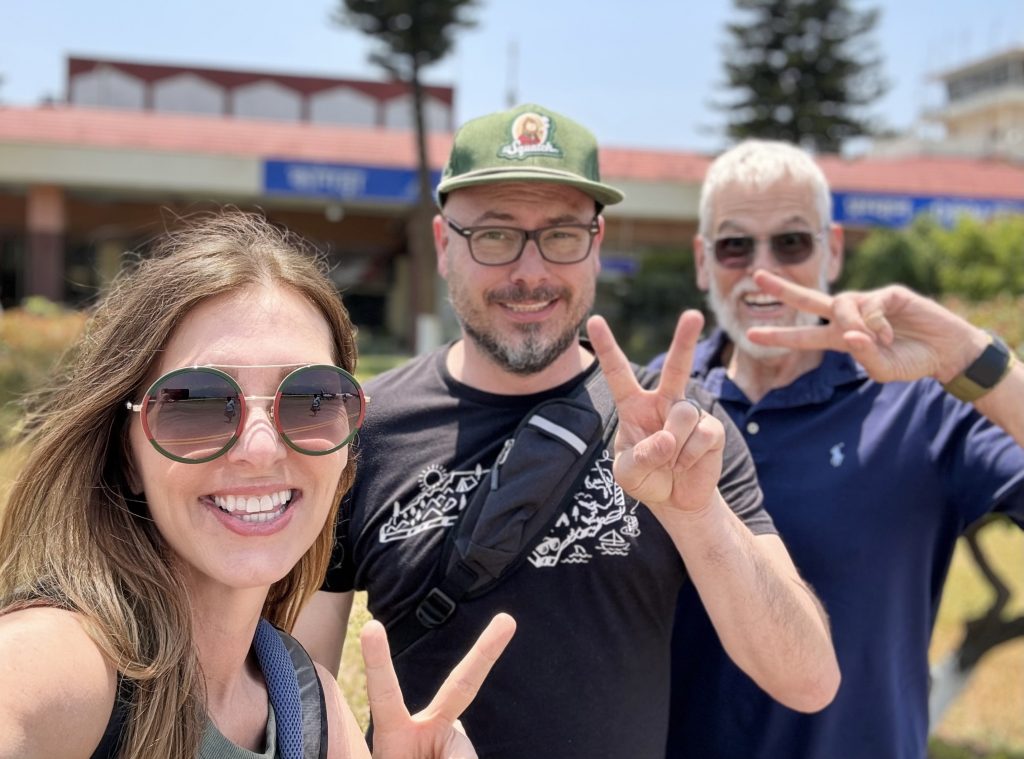
Once we landed, we grabbed a taxi outside the tiny airport and began the winding 45-minute drive into the mountains. Horns echoed around blind corners, the roads narrowed to near single-lane, and the hills seemed to rise around us. It was the perfect welcome to McLeod Ganj.
We checked into King Palace, a basic mid-range hotel about a ten-minute uphill walk from the center of town. Despite the name, it’s far from luxurious—but it’s clean, quiet, and well located.
The mountain air, while still warm, felt like a balm after the stifling heat of Delhi.
Bags dropped and legs stretched, we made our way straight to lunch at Tibet Kitchen, my tried-and-true favorite. It didn’t disappoint. We ordered two plates of vegetable momo, two cups of Tibetan butter tea, and one order of crispy fries—all for 720 rupees (about $8 USD). Comfort food with a spiritual kick.
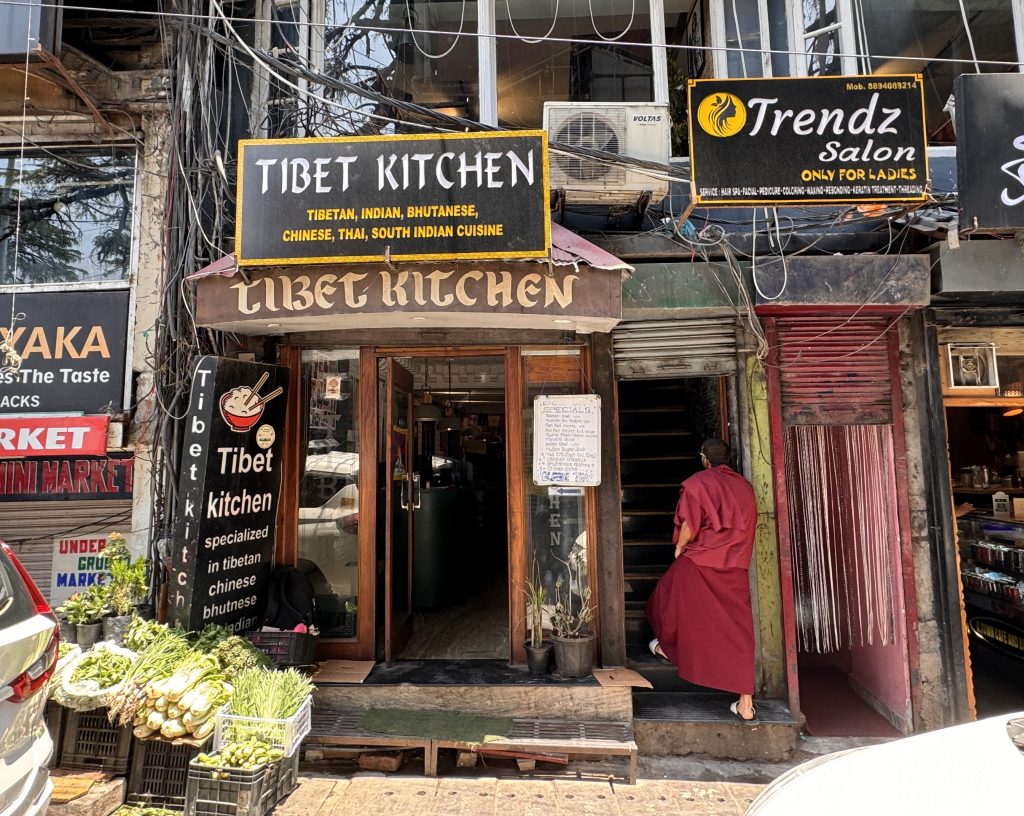

After lunch, we wandered over to the Namgyalma Stupa, located right in the center of town, tucked between Temple Road and Jogiwara Road. It’s surrounded by cafés, shops, and a steady stream of people—but despite all that, it feels like its own quiet world.
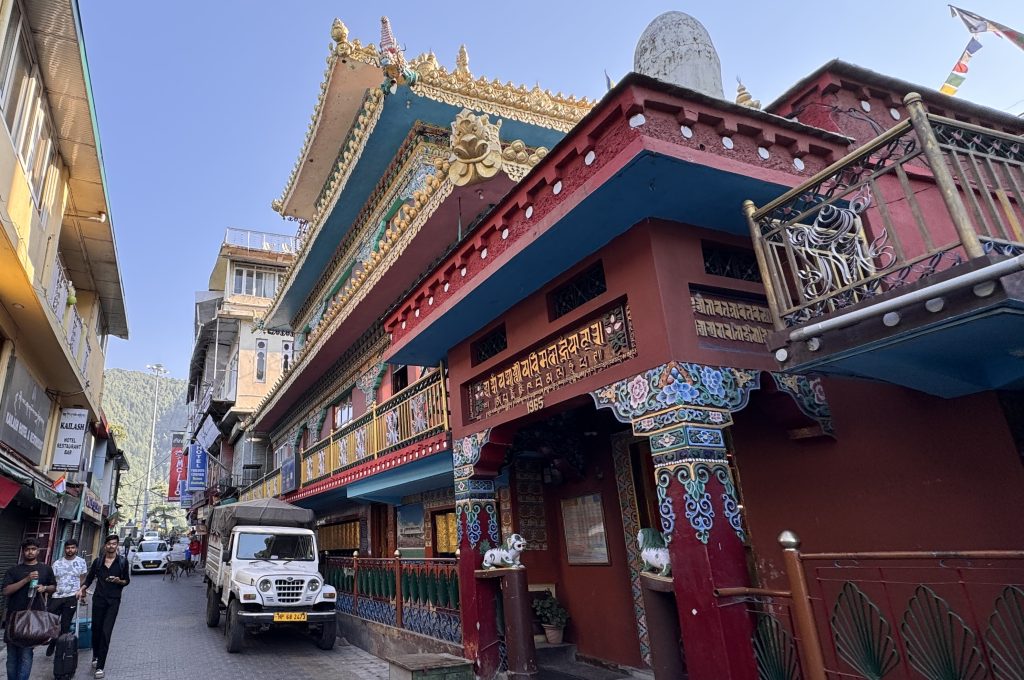
The temple structure stands out with its gold roof, upturned eaves, and detailed carvings. Prayer wheels line all four sides — their surfaces worn by the thousands of hands that have turned them. We joined others in walking around the building three times, spinning the wheels as we went—a traditional Tibetan Buddhist practice said to send prayers out into the universe.

Inside the open-air structure sits the Namgyalma Stupa, built to honor Tibetan soldiers who died during Tibet’s freedom struggle. It’s sometimes referred to as the Stupa of Blessings. According to tradition, it symbolizes the Buddha’s victory over death and is modeled after the original stupa where he granted longevity to sentient beings. It’s painted in gold and adorned with vibrant, colorful accents.
As we stepped inside, we heard the echo of chanting monks. Deep, rhythmic voices filled the space, accompanied by gongs and the haunting sound of a gyaling—a traditional Tibetan woodwind. We were given floor pillows to sit on, and we stayed for a bit, just listening. The sound seemed to move through the space more than echo off it—low, vibrating, timeless.
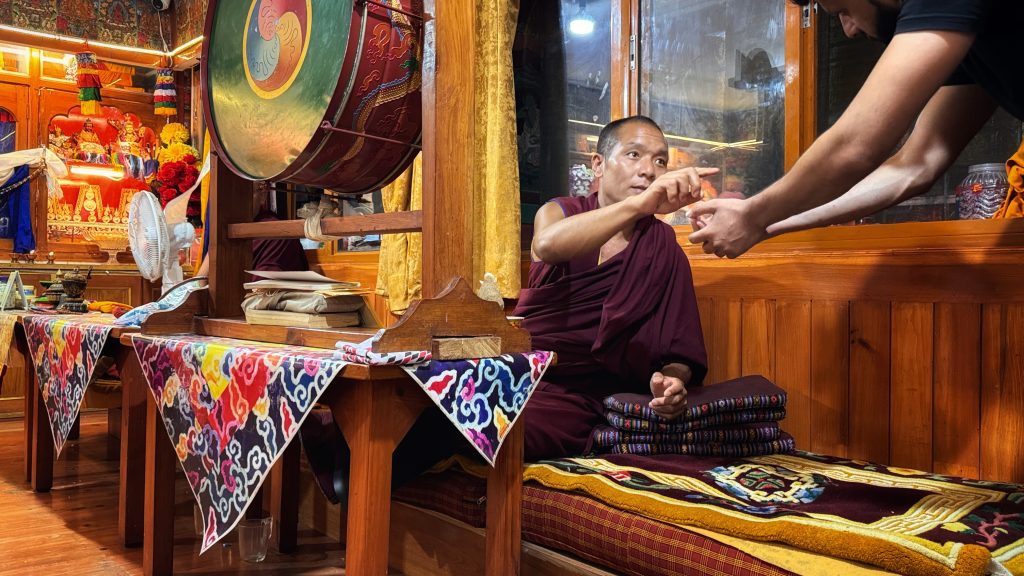
On our way out, we passed a few monks in the temple kitchen, quietly absorbed in crafting ornate ceremonial offerings made from butter and barley flour. They stood around a low wooden table, shaping tall, tapering forms and decorating them with delicate flowers and sacred symbols. Each piece was precise and intentional, and the monks worked with a meditative calm—their hands moving slowly, as if the act itself were a form of prayer.

And then—what has become a daily ritual for me in McLeod Ganj—we headed off to walk the kora, the sacred path that winds around the Dalai Lama’s residence and the entire Tsuglagkhang Complex.

The path is just over a mile long and lined with hundreds of prayer wheels, walls of mani stones carved with Tibetan mantras—many with the sacred phrase Om Mani Padme Hum, a chant for compassion—along with shrines, stupas, and fluttering prayer flags suspended between the trees.
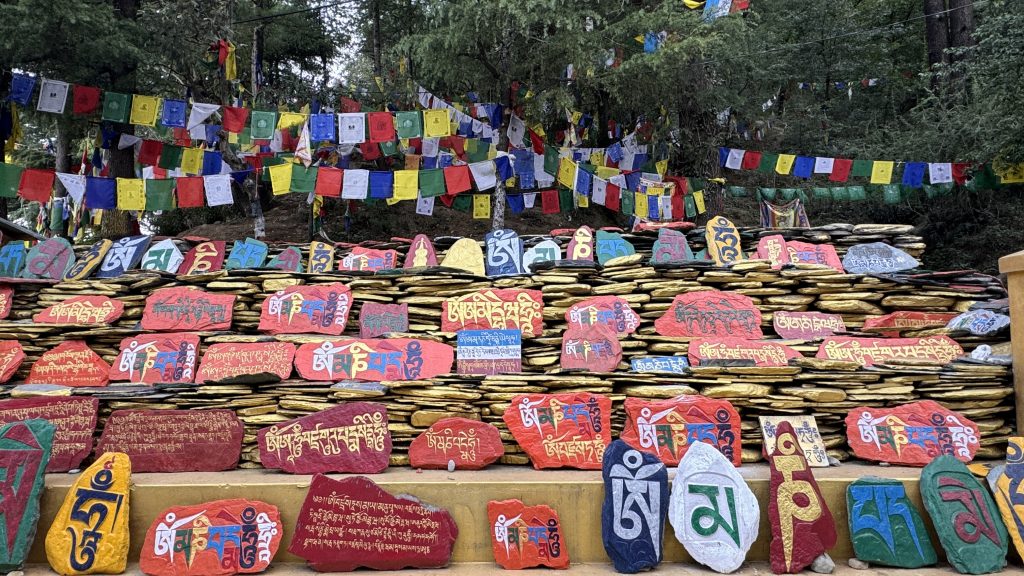

The prayer flags are everywhere—strung from branches, rooftops, railings—little squares of cloth fluttering in the wind. They carry mantras into the air with every breeze, and it’s honestly beautiful to see them flying in every direction.

One day, Mark and I hung several of our own, each one filled with the names of people we love and care about—those still with us, and those who’ve passed. It felt incredible to place ours among all the others, like adding a small thread to something much bigger than ourselves.
Prayer flags are hung year-round, but they’re taken down each year on July 8, the Dalai Lama’s birthday—a way of honoring that the prayers have been carried, and it’s time to begin again.
Others were walking the kora too—monks and nuns, local Tibetans, and yes, the occasional cow or two, ambling peacefully alongside us. Overhead, macaques watched us from the branches, sometimes hopping along the stone walls that flank the trail.
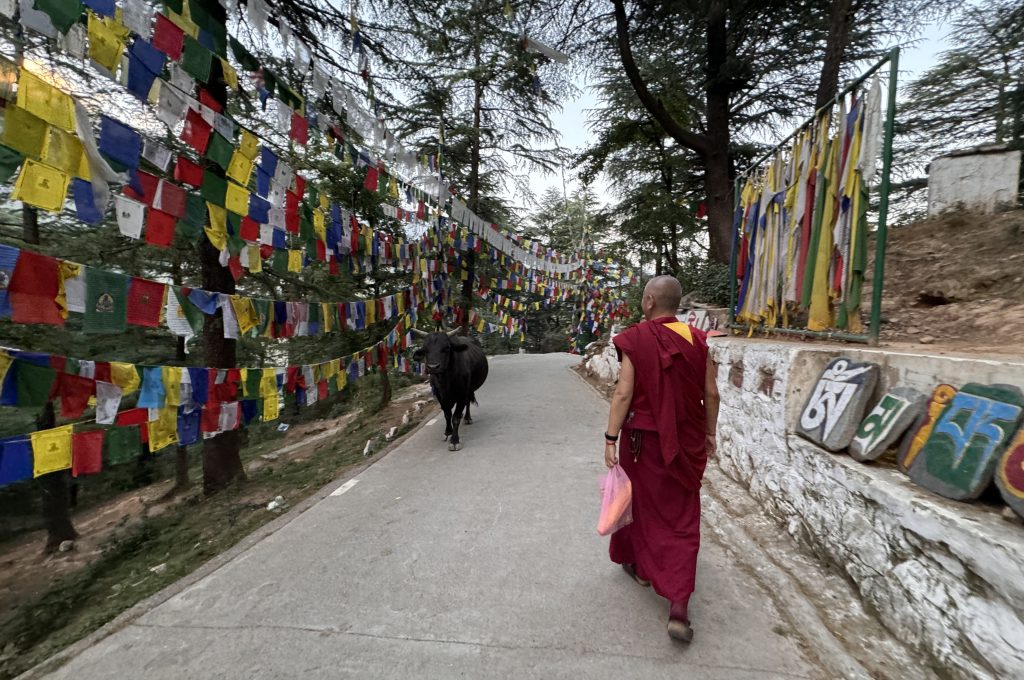
One of my favorite sections of the kora opens to a wide view of the Dhauladhar mountains, their snow-capped peaks glowing faintly in the afternoon light. It always takes my breath away. There are several benches along the way, perfect for sitting, resting, or just soaking it all in.
Along the path, some people had left small mementos at the base of shrines or statues—tiny offerings of thanks, prayer, or memory. Mark actually left a few behind on his last day, quiet gestures folded into the landscape.
We returned to the kora every morning and again at dusk—our way of greeting and closing the day.
After finishing the outer kora, we headed to the Tsuglagkhang Complex—also known as the Dalai Lama Temple—and walked around the main temple three times, turning the prayer wheels as we went. Mark walked quietly beside me, and though we didn’t say much, the act itself said enough.

Then we stepped inside the main prayer hall, where the Dalai Lama gives his teachings when he’s in town. The space isn’t huge, but it’s full of presence. A large golden Buddha sits at the front, and in front of it is the Dalai Lama’s seat, draped in gold cloth. You can’t miss it.
Behind it were rows of colorful butter sculptures and a mix of offerings—fruit, candles, packets of snacks, butter lamps, and ceremonial scarves. Along the side walls were glass cases filled with wrapped scriptures, and the smell of incense lingered in the air.
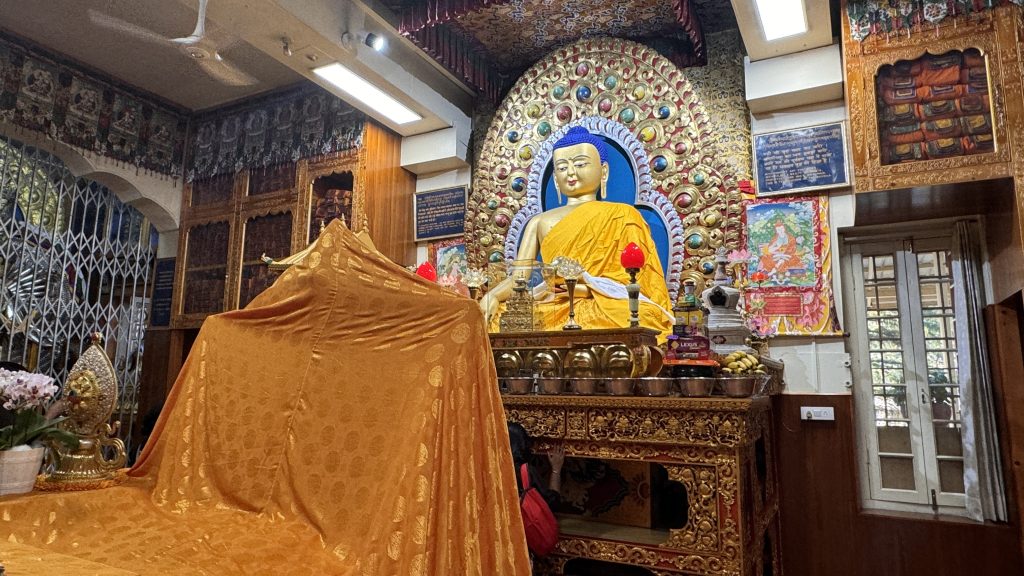
It was quiet, peaceful, and somehow both simple and sacred at the same time.
By dinnertime, we were ready for something satisfying but simple, so we headed to Jimmy’s Italian Kitchen. Despite the name, we weren’t there for pasta—we were there for more momo. That’s right: Tibetan dumplings at an Italian restaurant. Jimmy’s is a cozy little second-floor spot with mismatched furniture, a bookshelf full of paperbacks, and a half-open kitchen in the back.
The momo were tasty and hit the spot.
And just so I don’t repeat myself every day: we’re kind of freaks for momo. Mark, Tom, and I basically lived on them the entire trip—often for both lunch and dinner. Usually with a side of chili fries, and occasionally a bowl of thukpa (Tibetan noodle soup). Family-run momo spots are everywhere in town, and we were more than happy to keep taste-testing.
Want the full breakdown? I wrote more here:
8 Days of Momo: The Best Bites in McLeod Ganj, India
Back at the hotel, we ended the night on the balcony with a couple of Kingfisher beers, the lights of the town flickering below and the cool mountain air settling in around us. We were tired but very full—in every sense of the word.
What a first day.
We started the day with a walk to Nechung Monastery, home to the Nechung Oracle, who serves as the state oracle of Tibet and offers spiritual guidance to the Dalai Lama. The walk took about 30 to 40 minutes, mostly downhill, with warm sun and just enough breeze to keep it from feeling oppressive.
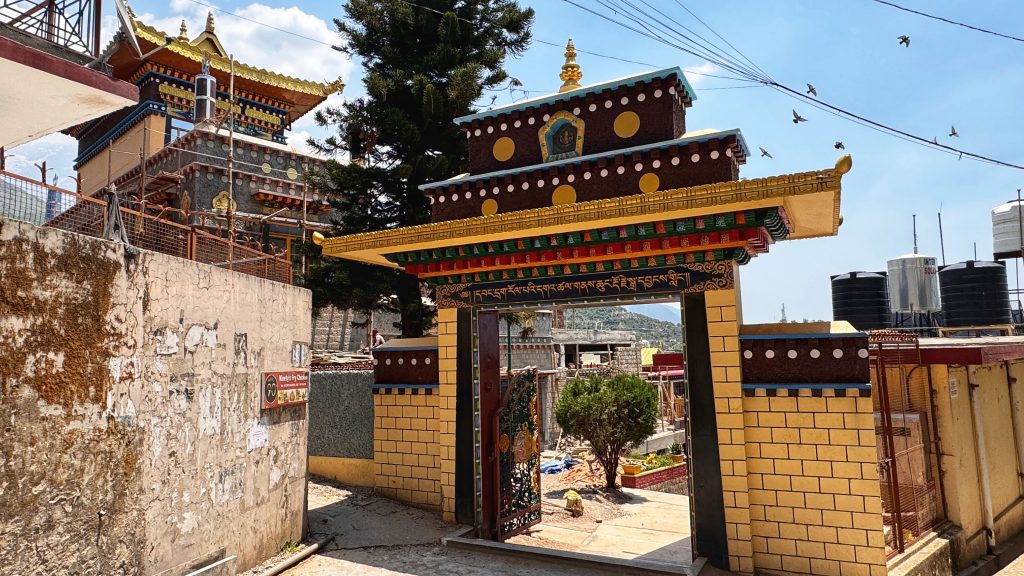
Unfortunately, the gompa was under renovation, so we couldn’t access the full interior. But a small temporary shrine was open to visitors. Even in its pared-down form, the space felt significant—quiet, humble, and full of history. Nechung holds an important place in both religious and political life, and standing there felt quietly meaningful.
By the time we wrapped up at the monastery, it was definitely time for lunch, and we made our way to the small canteen next door. Nothing fancy—just a few tables, quick service, and exactly what we were craving: momo and sepen.
The momo were hot and delicious—stuffed with cheese and just 100 rupees per order (a little over a dollar). We paired them with a bowl of sepen, the Tibetan chili sauce that’s tangy, spicy, and addictive.

After lunch, we grabbed a cab back to McLeod Ganj—the sun was blazing, and none of us felt like tackling that uphill walk.
After lunch, we decided to try out the Dharamsala Skyway, a new cable car that now connects McLeod Ganj to Lower Dharamsala. It wasn’t here the last time we visited, so it felt like a whole new way to see the area.
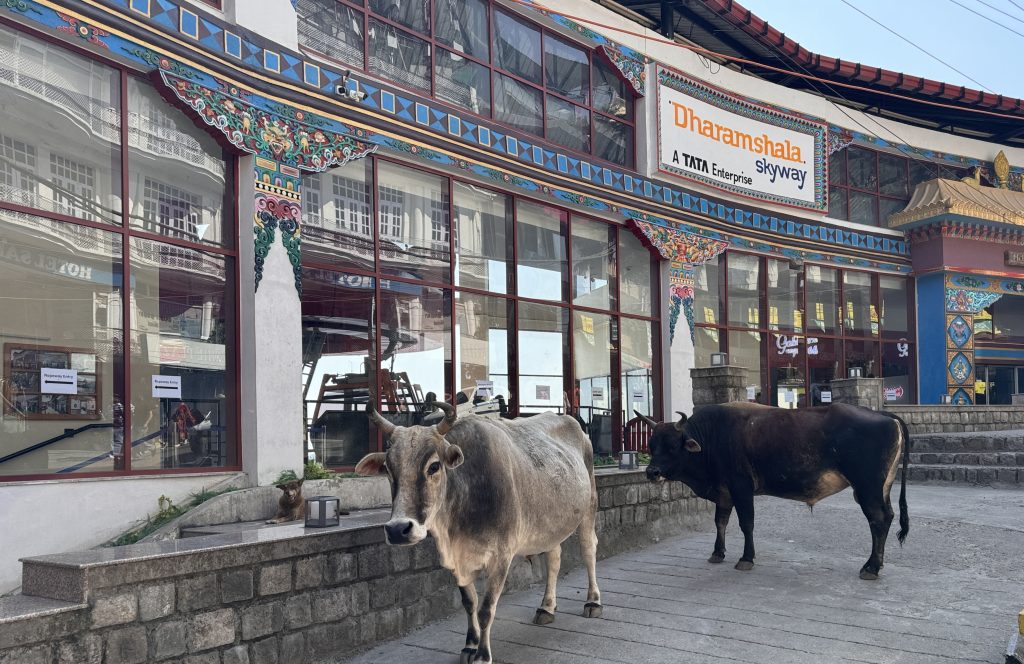
The ride took about 7–10 minutes, and it was surprisingly smooth and quiet. On a clear day like ours, the views were stunning—rooftops, hillsides, and forested slopes all unfolding beneath us. It really hits you just how high up McLeod Ganj sits when you’re floating above the valley looking down.
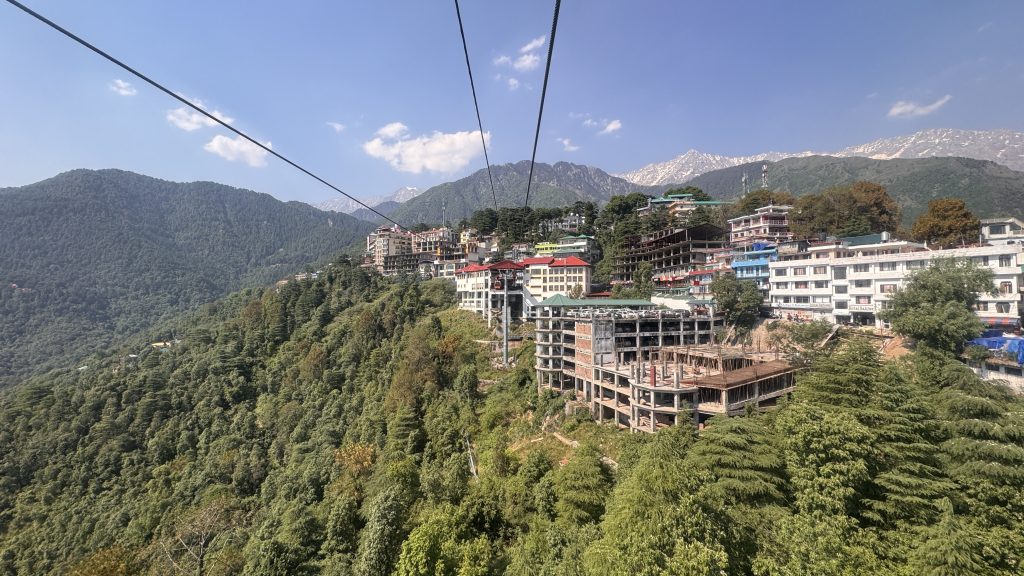
But the moment we stepped off at the bottom, everything changed.
The cable car dropped us near what I think was the garment district, and the contrast was immediate. Lower Dharamsala buzzes with life—fruit vendors yelling prices, scooters weaving through crowds, kids running past piles of fabric.
Signs for Samsung and Vivo hung above stalls selling onions, bananas, and cellphone cases. Tailors worked from second-story balconies above the street, sewing machines whirring behind open windows.
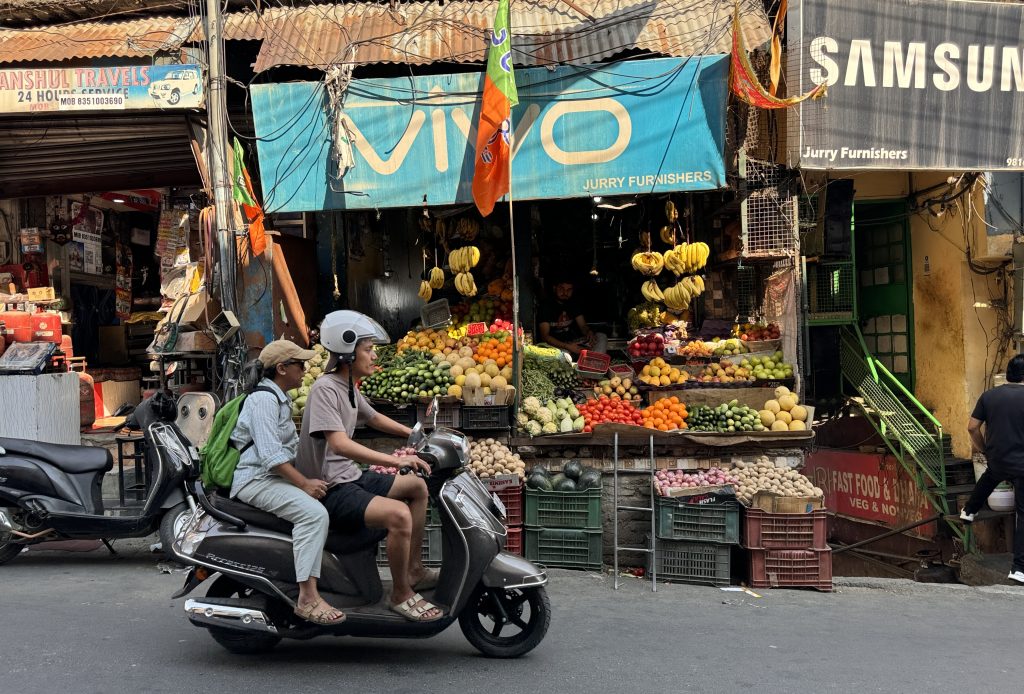
It was a photographer’s dream.
Mark and I both had our cameras out instantly. Later, when we compared photos, it was fascinating to see what we’d each focused on. Same moment, same streets—but completely different eyes. That’s one of the things I love most about traveling with him: the way our perspectives complement each other.
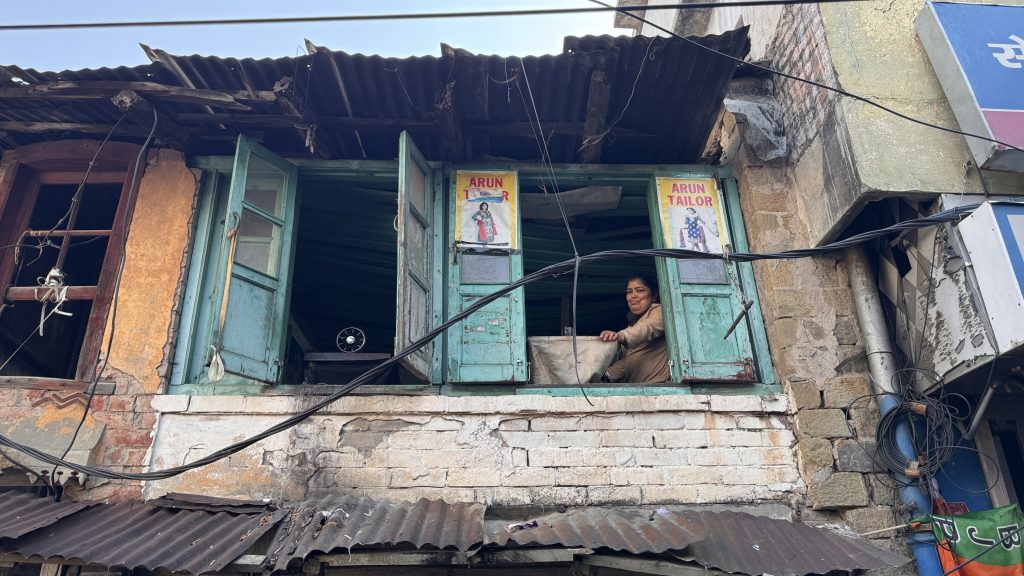
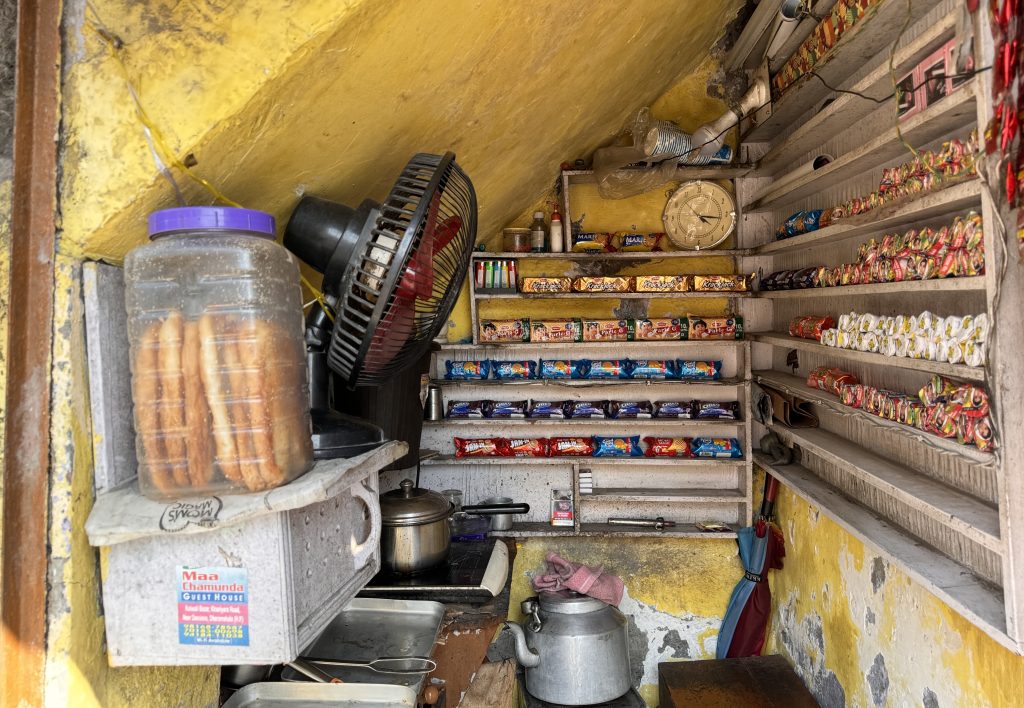
After a few hours of exploring, we caught the cable car back up to McLeod Ganj. The town has its own kind of chaos—busy, yes, but with a thread of reflection and spiritual rhythm running underneath it. Lower Dharamsala feels more purely Indian: louder, faster, more focused on daily hustle. McLeod Ganj, shaped by Tibetan culture, has a different energy altogether.
The two places are only minutes apart, but in some ways they feel worlds away.
The streets are just as crowded up top, but there’s a calm beneath the noise—maybe it’s the monasteries, the prayer flags, or just the mountain air. Whatever it is, it gives the place a sense of grounding.
It was a day rich with contrasts—visually, culturally, emotionally.
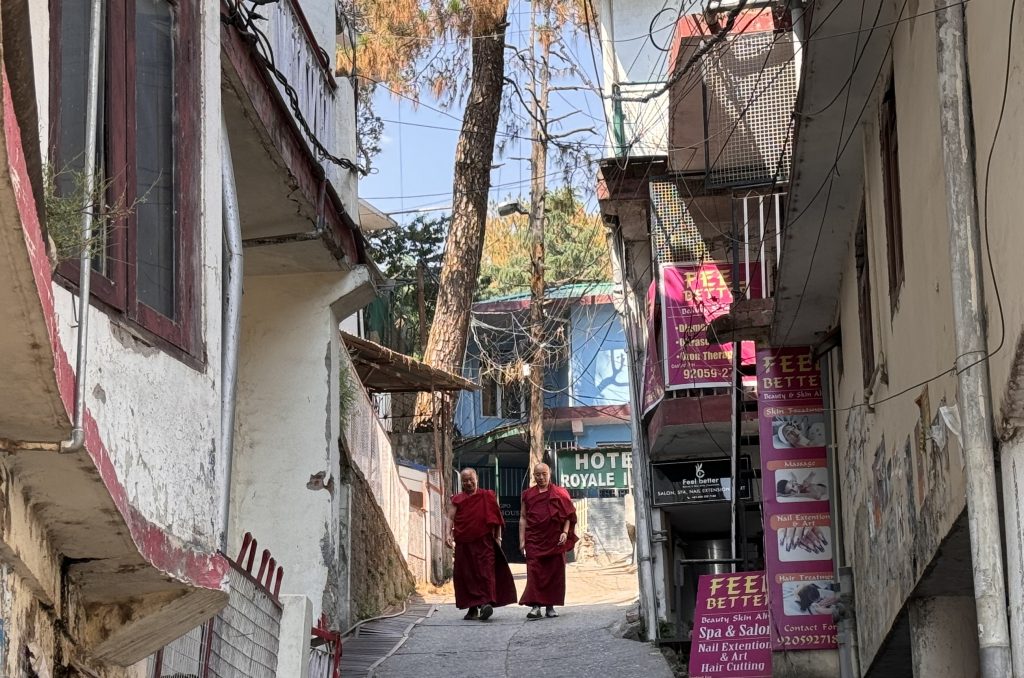
Today was all about nature for Mark and me. I’ve done some hiking in the area on past trips, and since I don’t know the trails well enough to go it alone, I always book with a company I trust—Manu Adventures India. I’ve used them on every trip, and they’ve never let me down.
Our hiking guide picked us up at our hotel in the morning, and we set off toward the Triund trailhead—first heading out of town, then up a narrow, pothole-filled dirt road that twisted through the trees. It jolted and jostled the whole way—an adventure in itself. By the time we reached the start of the trail, we were already laughing and brushing off a thin coat of road dust.
Then we set off on foot for the hike.
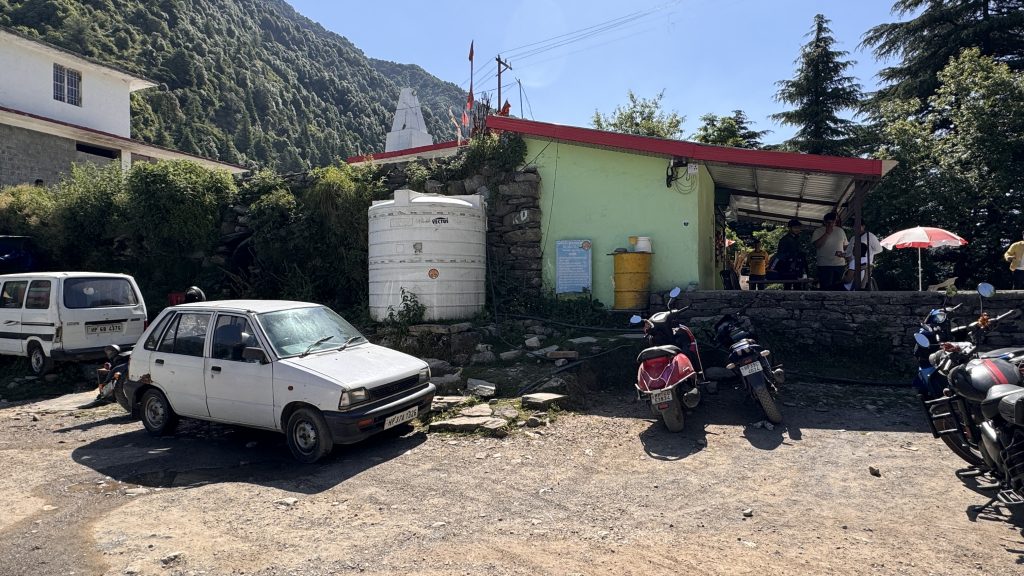
The Triund Hike is known for its spectacular views of the Dhauladhar Range, and I knew it would impress Mark. It’s not a long hike—just under five miles round trip. But, it’s steep and a bit challenging— especially near the top, where 22 switchbacks in the final stretch will absolutely test your legs.

The trail is mostly rocky, though some stretches are shaded by forest canopy. As you climb, the views start to open up—Bhagsu, McLeod Ganj, and Dharamsala spread out below like a sea of red and green rooftops. The higher you go, the quieter it gets—just the sound of your breath and the occasional crow overhead.
About halfway up, we stopped at Magic View Café, a little mountainside tea stand that’s been around for over 40 years. The owner runs it on land his father once farmed, and it’s the perfect place to catch your breath, have a Snickers, and let your guide sip a chai.
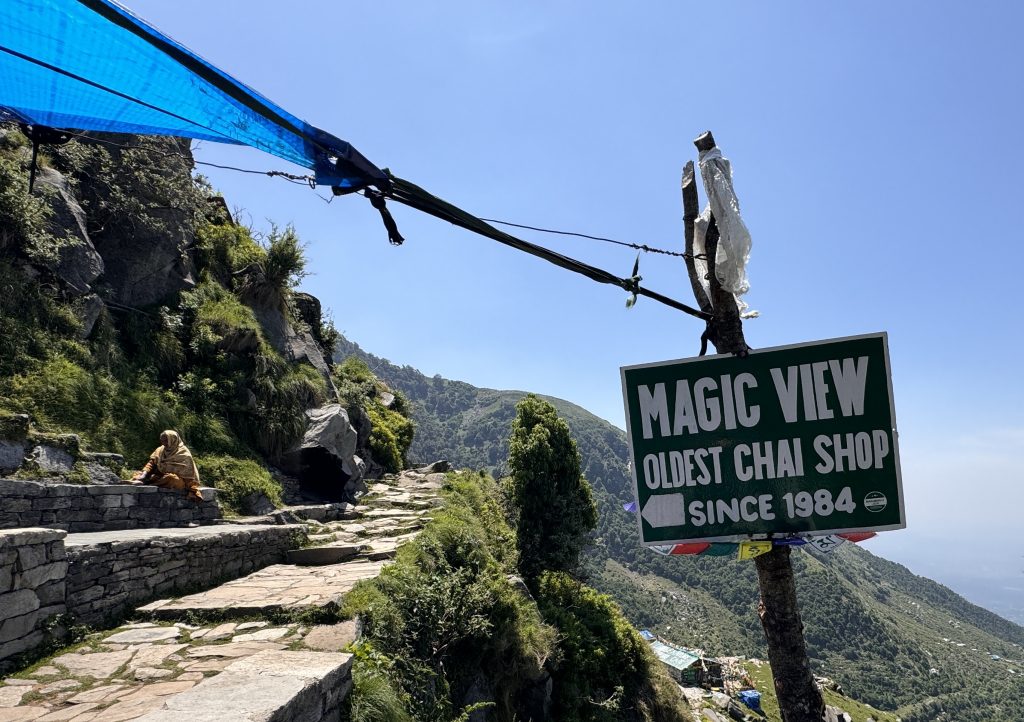
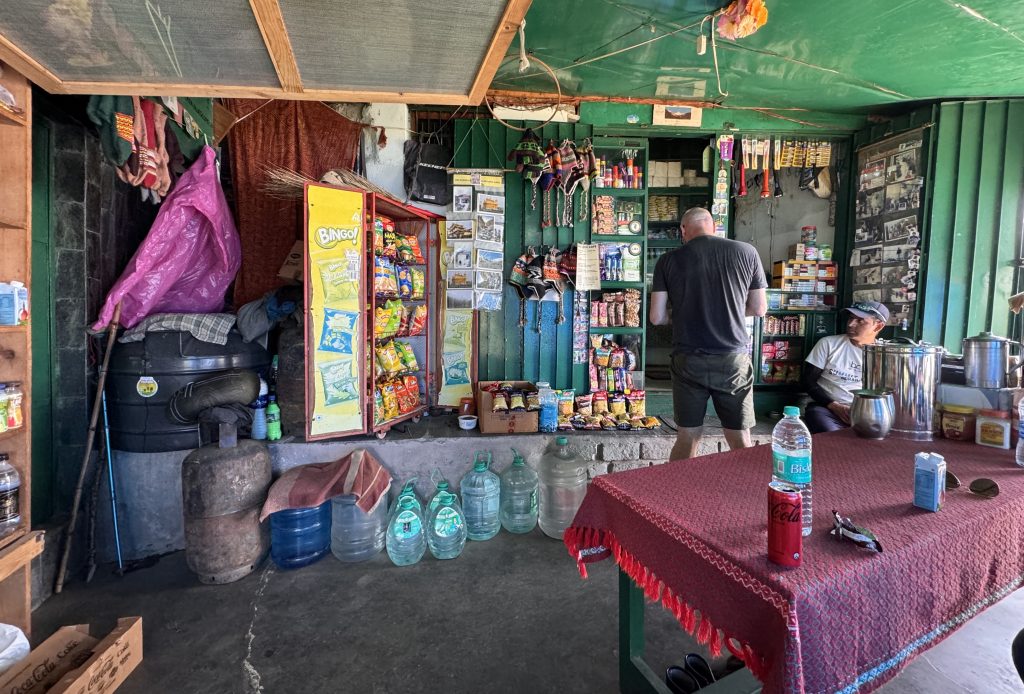
Supplies are brought up by mule, and while we were resting, a few happened to arrive—climbing that rocky path like it was nothing, loaded with goods.
The owner even let me put one of my Travelsafoot stickers inside the shop, which made me weirdly proud.
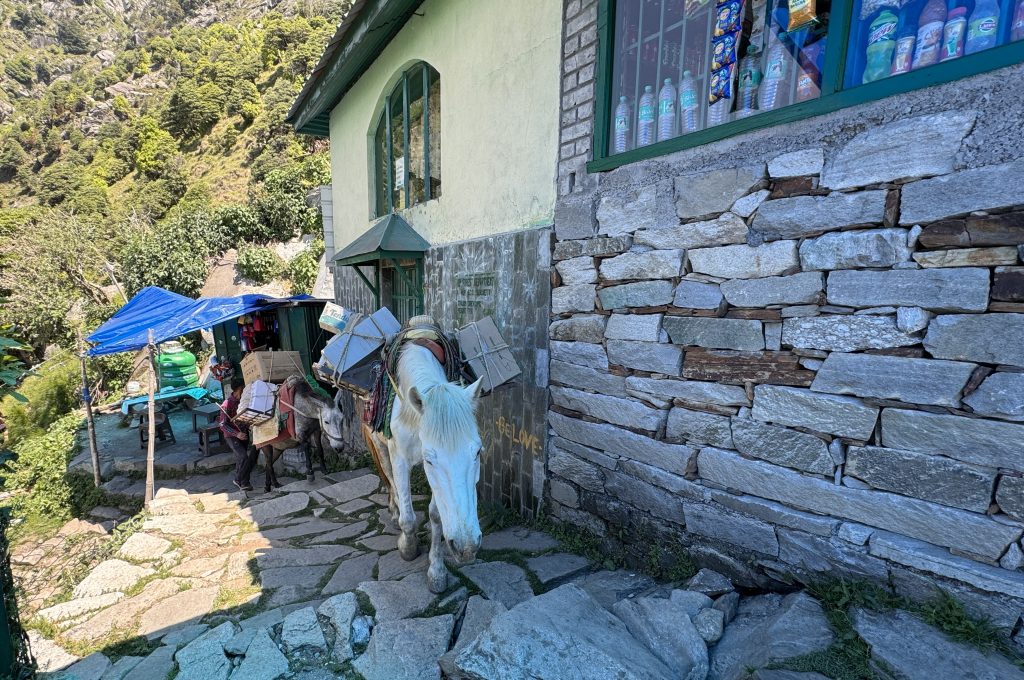

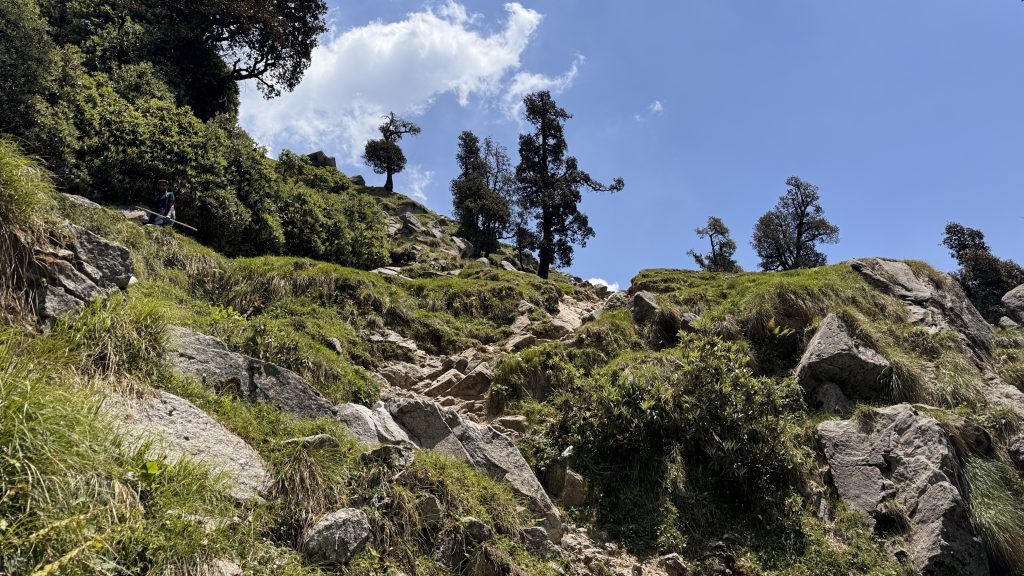
The weather couldn’t have been better—blue skies, cool breeze, and the snow-covered Dhauladhar peaks glowing up ahead. At the top, we wandered for a while, took photos, found a quiet spot to sit, and just took it all in.

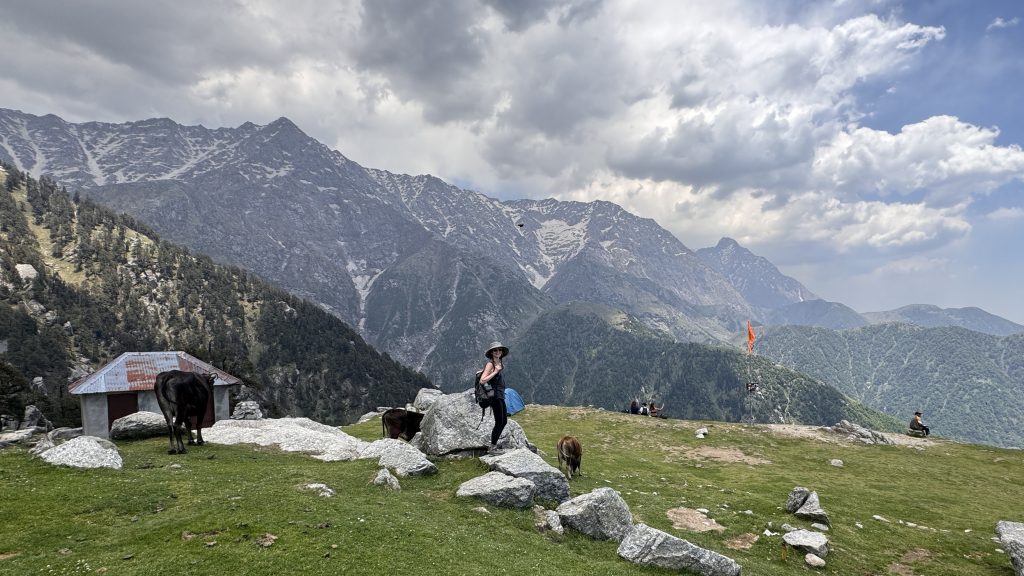

We’d brought prayer flags to hang together, and finding the right place to leave them felt really special. We tied them up side by side, high in the wind, our little tribute tucked among so many others. Something about leaving them there—those names, those hopes—made the day even more meaningful.

It was a fabulous day. One I know I’ll carry with me.
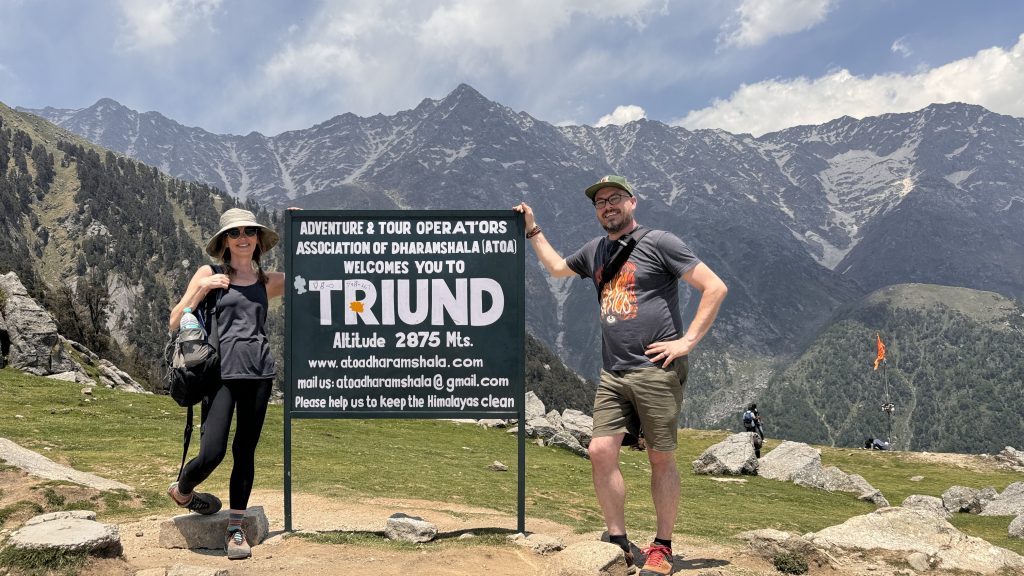
The day began with a drive out to Gyuto Monastery, one of the quieter and more majestic spots in the area. Set against the dramatic backdrop of the Dhauladhar range, the monastery had a stillness about it that you could feel as soon as we arrived.
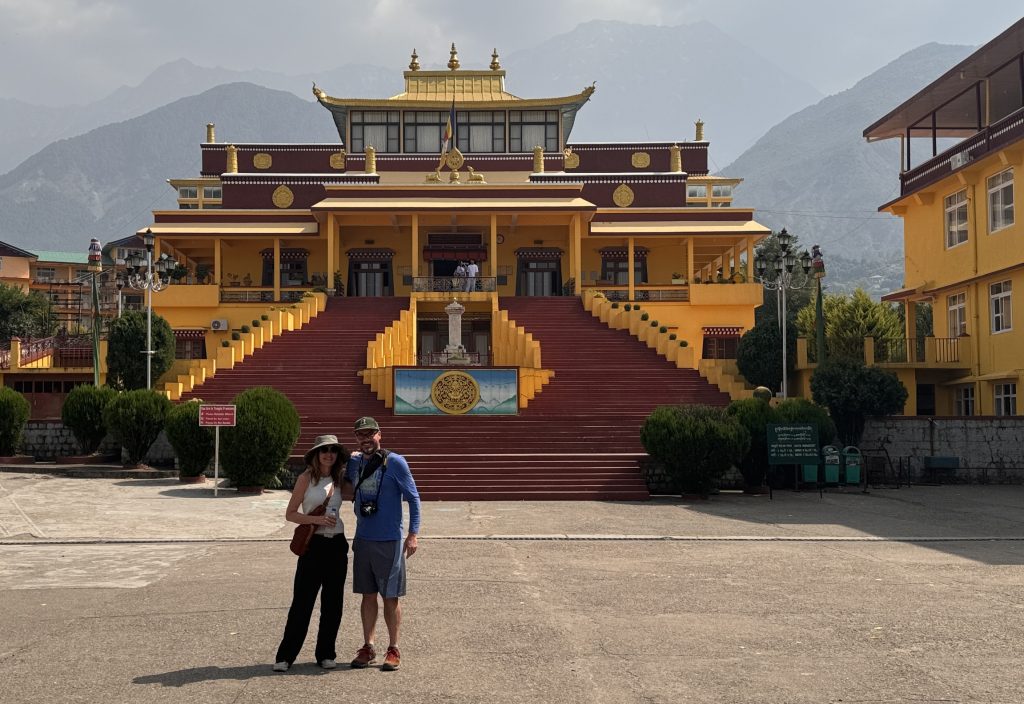
Not long after we entered, we spoke with a friendly monk. I asked about requesting a puja—a spiritual ceremony involving chanting, offerings, and ritual prayers. Often done for healing, protection, or in honor of loved ones, a puja felt like the right gesture for this moment. He directed us to the office, where a couple of monks kindly helped me submit a request—for family, friends, and a few intentions of my own. The ceremony would take place later that afternoon.
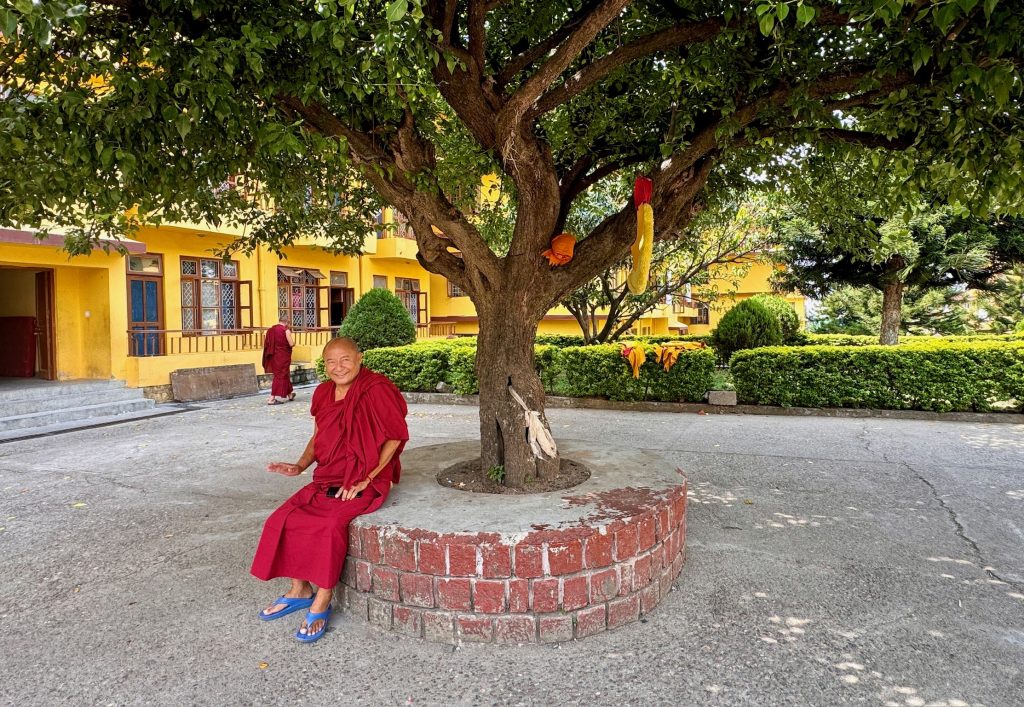
With a few hours to spare before the puja, we decided to take a short taxi ride to the nearby Norbulingka Institute—a campus dedicated to preserving Tibetan Buddhist art and culture.
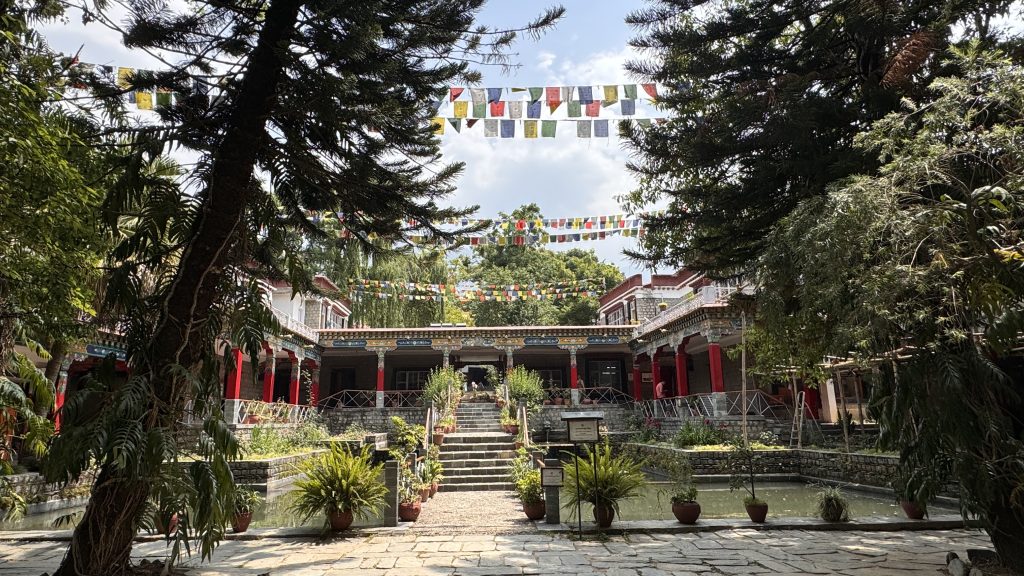
We wandered in and out of studios, the whole place moving at a quiet rhythm. Artists were sketching or painting intricate thangka scrolls, others carving traditional Tibetan patterns into wood. One master carver wasn’t even using a pattern—just working freehand with calm precision.
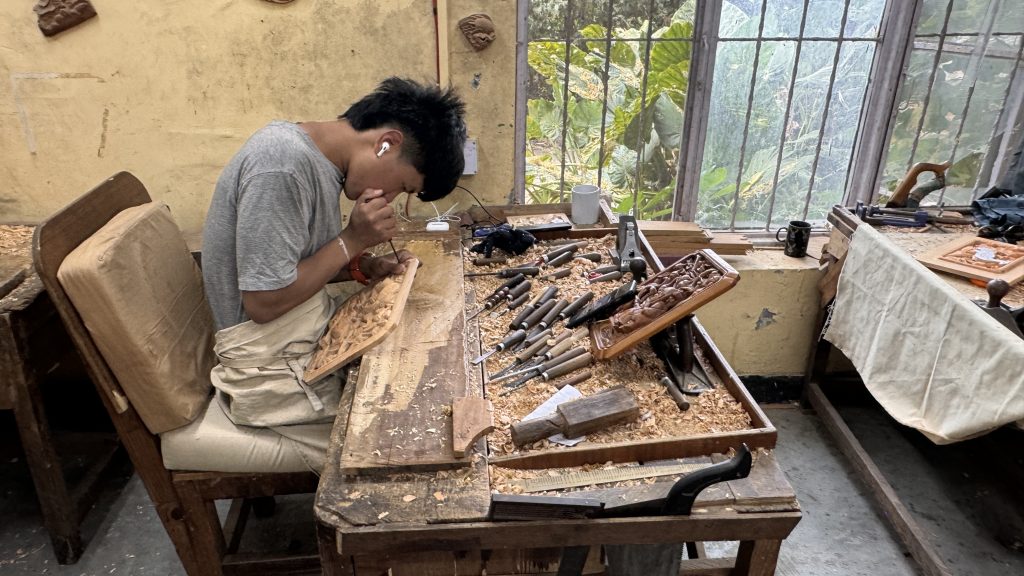

In another room, an artist was painting colorful designs on boxes and trim, each line placed so carefully it was almost meditative. The work wasn’t just beautiful—it was a living tradition, carried on with care and intention.

An hour and a half passed quickly. We made our way back to Gyuto Monastery for the afternoon ceremony.
We arrived at 12:30 p.m., just as hundreds of monks were entering the gompa, dressed in gold ceremonial hats and robes. We followed quietly through the main entrance, removed our shoes, and slipped into the prayer hall through a side door


Inside, we found a spot to sit on the floor mats that lined the back wall. The monks sat on eight long benches, arranged along either side of the central aisle and facing inward toward the altar.
At the front of the hall stood a towering golden Buddha statue, serene and radiant. Behind it, rows of smaller statues filled tall glass cases. The altar was crowded with offerings—butter lamps, fruit, packaged snacks, ceremonial scarves, and other sacred objects
Eventually, the chant master stood at the back of the central aisle with a microphone and a set of scrolls. He began to chant—slowly, rhythmically—reciting the prayers tied to each puja request. His voice filled the room, deep and steady, resonating off the walls and settling into the space like something ancient and alive.
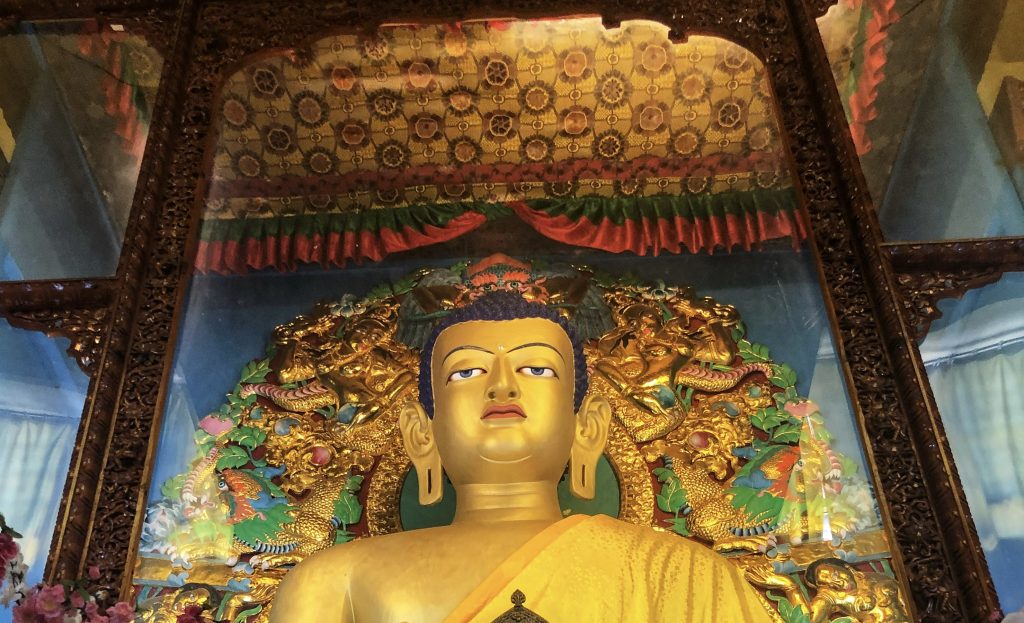
Then, he began reading names. Most were spoken in Tibetan, and it was hard to catch them. But then I heard three clearly:
My mother’s name—Joan.
My daughter’s name—Jessica.
And my own—JoAnne Cross.
It stopped me cold.
To hear those names spoken aloud—woven into centuries-old prayers, inside that sacred hall—was overwhelming. Surreal. Humbling. Powerful.
Today was the day Mark’s entire trip was built around—his audience with His Holiness the Dalai Lama. We didn’t know exactly what to expect. Believe it or not, Tom and I had been lucky enough to meet His Holiness on both of our previous visits. I know—it’s insane. I don’t even understand how I’ve been fortunate enough to have this honor not just once or twice, but now a third time. And each time has been different. This one would be, too.
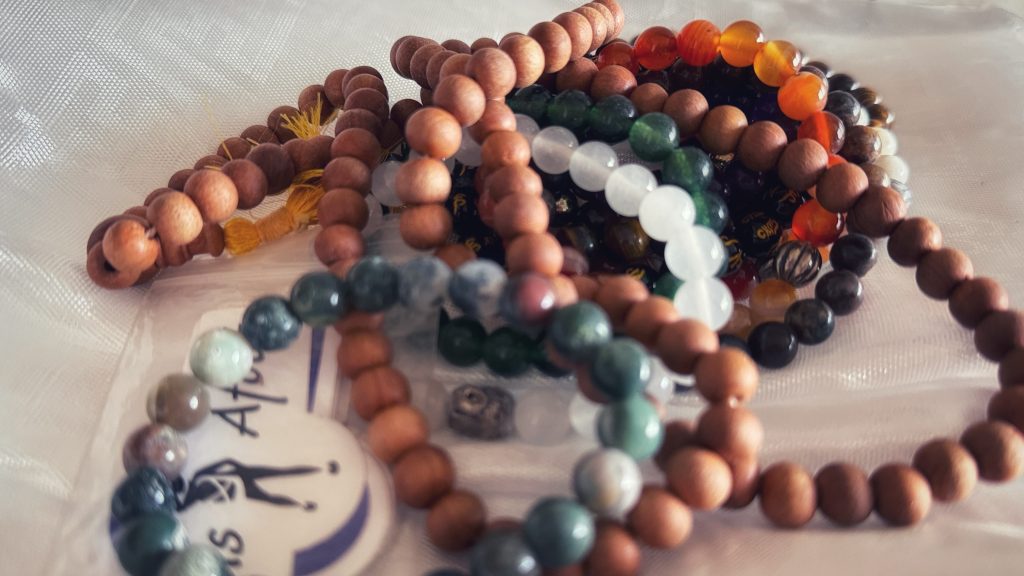
When we arrived at the appointed time, we were sorted into a line according to when we’d be called up. My heart always pounds in those moments. On our previous visits, the Dalai Lama had entered the room from outside and walked to his seat, greeting guests along the way. This time, he was brought out from within the temple building.
The line began to move. From what I could see, people were being called up one by one.
Tom’s name was called first. He walked up alone, received his blessing, and spent a few quiet moments with His Holiness. And then—mine was called.
“JoAnne Cross from the United States.”
I stepped forward with my prayer beads in hand. His Holiness reached out and gently took both of my hands in his. We locked eyes, and as he began his blessing, I felt this wave of emotion surge through me. His presence was warm and grounding—his touch somehow both calming and electrifying.

He held my hands for a moment, then slowly raised his right hand and placed it on my forehead.
I’m not a particularly religious person; I wouldn’t even say I’m especially spiritual. But in that moment, I was completely overwhelmed. Gratitude, reverence, peace—it all flooded in. It was the most intimate, powerful experience I can remember.
And then I heard my son’s name called.
My heart just about exploded.
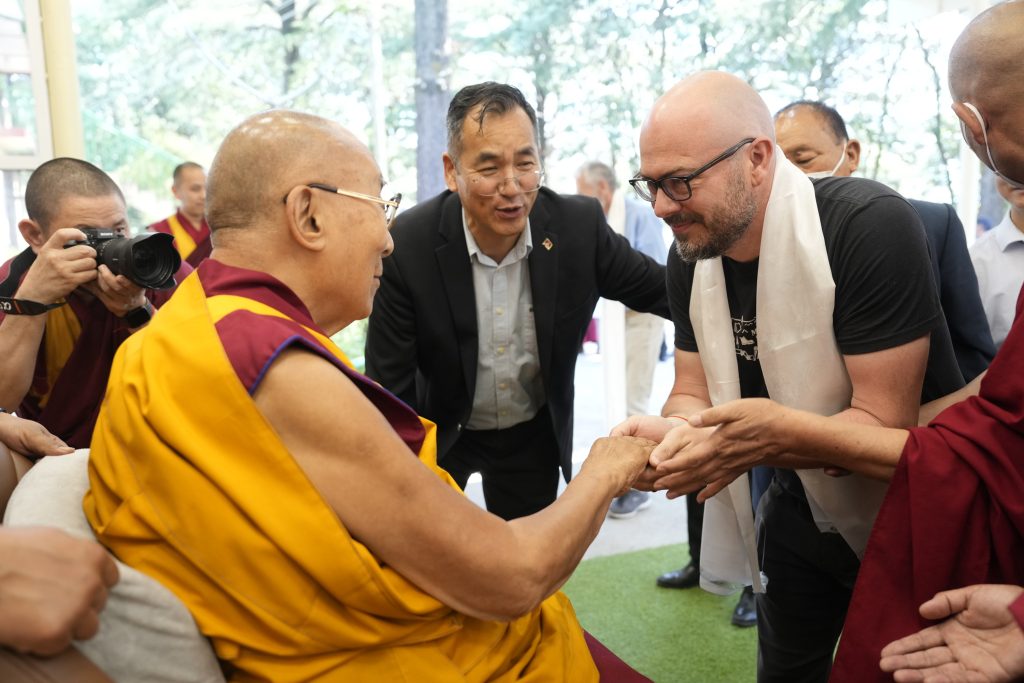
On Mark’s final day in India, he received a personal blessing from the Dalai Lama. It doesn’t get more meaningful than that.
The rest of the day couldn’t possibly compare to the morning, but we still had some time together. After lunch, we set out for a short hike to Bhagsu Waterfalls, one of the more popular walks in the area. The views were beautiful, but it was hot and very crowded. Luckily, the trail is lined with several cafés—very welcome when you’re desperate for a cold bottle of water.

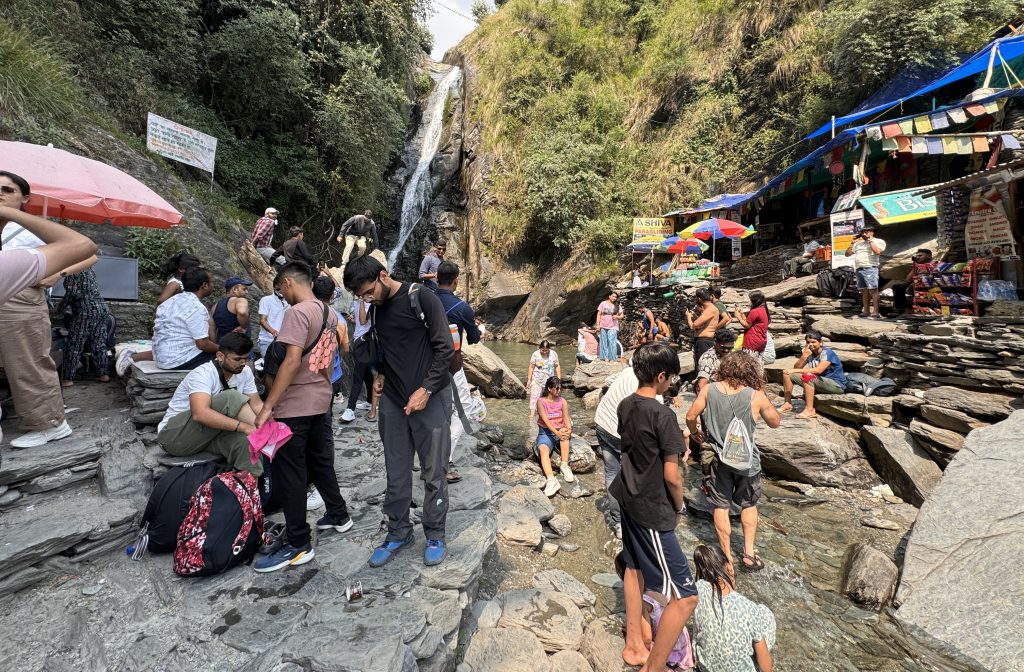

After reaching the falls and taking it all in, we made our way back down to McLeod Ganj—a nice, easy descent.
That evening, we went back to Tibet Kitchen for one last meal together—the same place where we’d started our trip. We ordered the Tandoori Paneer Momos, which might honestly be my favorite of the entire trip. Spicy, smoky, crispy perfection.

Throughout our time in McLeod Ganj, we kept hearing the same song in the background at cafés and restaurants—‘Memories’ by Maroon 5. It started to feel like the soundtrack to our trip.
‘Here’s to the ones that we got
Cheers to the wish you were here, but you’re not
’Cause the drinks bring back all the memories
Of everything we’ve been through…’
Now, whenever I hear it, I’m instantly back in that beautiful mountain town with my son—five unforgettable days, full of heart, laughter, and moments I’ll always hold onto.

Our time in McLeod Ganj was filled with spirituality, beauty, and connection—to each other, to tradition, and to something much bigger than ourselves. Whether we were exploring monasteries, trekking through the Himalayas, spinning prayer wheels, or sipping tea in the shadow of the Dalai Lama’s residence, each day brought something meaningful.
Yes, the town is noisy, sometimes chaotic—but there’s a peace that lingers in the air here. A gentleness underneath it all.
It’s a place that stays with you—and this time, more than ever.
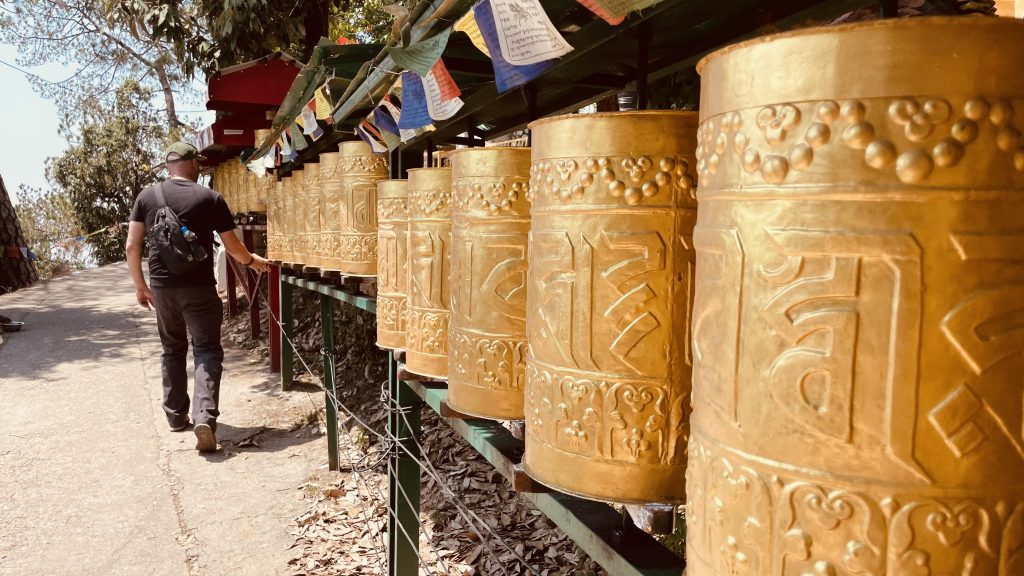
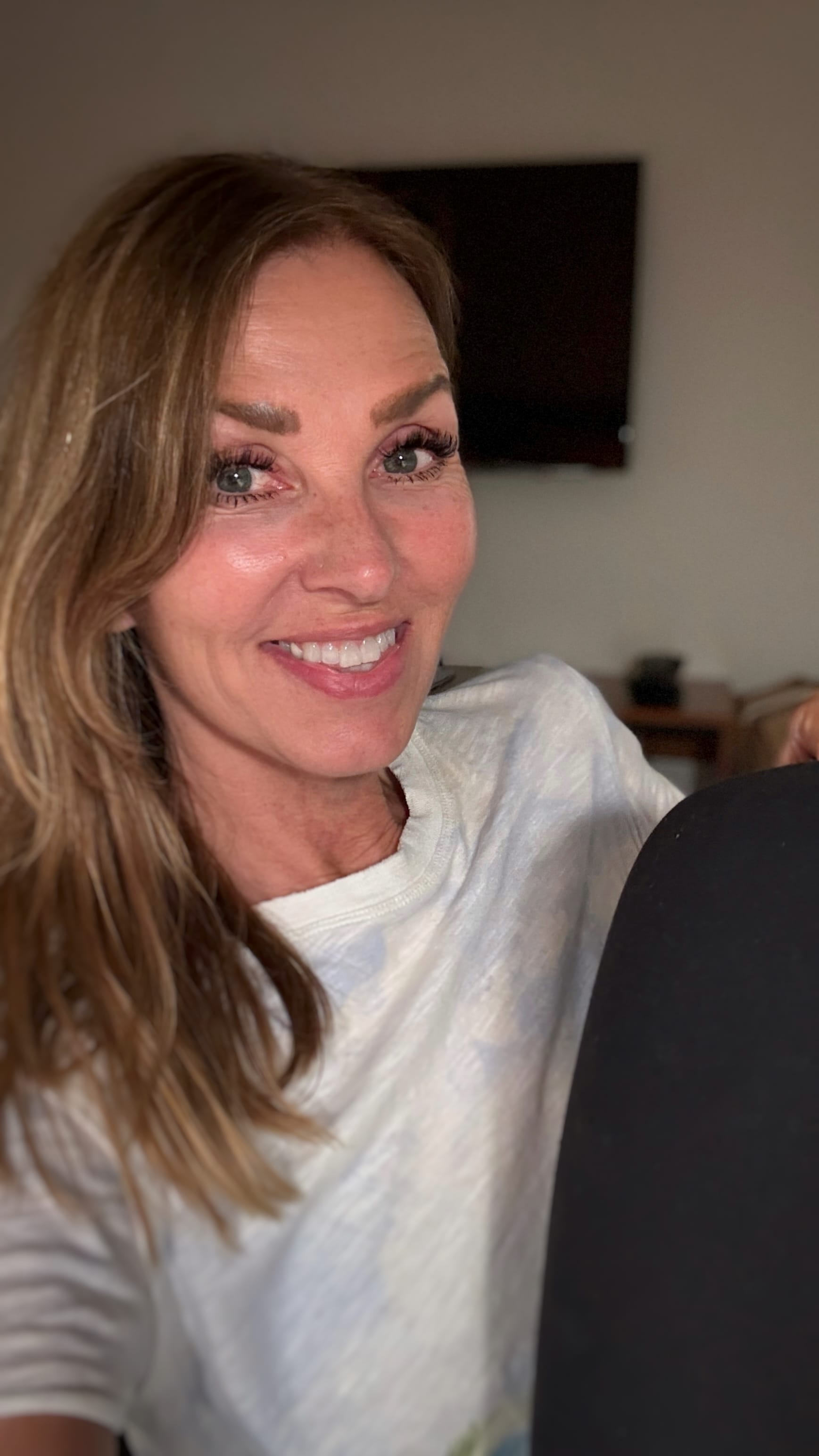
Hi, I’m JoAnne—writer, wanderer, and lover of places that surprise me. I’ve traveled to 60+ countries (and counting), usually with a camera in one hand and a notebook in the other. I’m drawn to mosaics, markets, and mountains, and I write to remember what moved me. When I’m not traveling, I’m working on my blog Travels Afoot, trying new creative projects, or planning my next adventure.